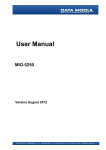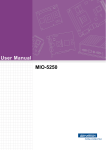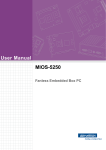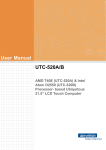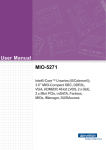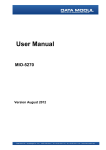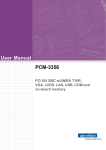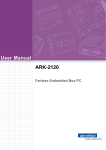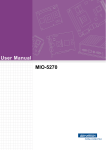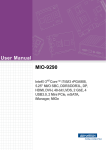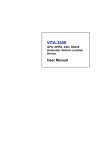Download Advantech MIO-5250 User manual
Transcript
User Manual MIO-5250 Copyright The documentation and the software included with this product are copyrighted 2012 by Advantech Co., Ltd. All rights are reserved. Advantech Co., Ltd. reserves the right to make improvements in the products described in this manual at any time without notice. No part of this manual may be reproduced, copied, translated or transmitted in any form or by any means without the prior written permission of Advantech Co., Ltd. Information provided in this manual is intended to be accurate and reliable. However, Advantech Co., Ltd. assumes no responsibility for its use, nor for any infringements of the rights of third parties, which may result from its use. Acknowledgements Intel® is a trademark of Intel® Corporation. Award is a trademark of Award Software International, Inc. VIA is a trademark of VIA Technologies, Inc. IBM, PC/AT, PS/2 and VGA are trademarks of International Business Machines Corporation. Microsoft Windows is a registered trademark of Microsoft Corp. RTL is a trademark of Realtek Semi-Conductor Co., Ltd. ESS is a trademark of ESS Technology, Inc. UMC is a trademark of United Microelectronics Corporation. SMI is a trademark of Silicon Motion, Inc. Creative is a trademark of Creative Technology LTD. CHRONTEL is a trademark of Chrontel Inc. All other product names or trademarks are properties of their respective owners. MIO-5250 User Manual Part No. 2006M52510 Edition 1 Printed in China March 2012 ii Product Warranty (2 years) Advantech warrants to you, the original purchaser, that each of its products will be free from defects in materials and workmanship for two years from the date of purchase. This warranty does not apply to any products which have been repaired or altered by persons other than repair personnel authorized by Advantech, or which have been subject to misuse, abuse, accident or improper installation. Advantech assumes no liability under the terms of this warranty as a consequence of such events. Because of Advantech’s high quality-control standards and rigorous testing, most of our customers never need to use our repair service. If an Advantech product is defective, it will be repaired or replaced at no charge during the warranty period. For outof-warranty repairs, you will be billed according to the cost of replacement materials, service time and freight. Please consult your dealer for more details. If you think you have a defective product, follow these steps: 1. Collect all the information about the problem encountered. (For example, CPU speed, Advantech products used, other hardware and software used, etc.) Note anything abnormal and list any onscreen messages you get when the problem occurs. 2. Call your dealer and describe the problem. Please have your manual, product, and any helpful information readily available. 3. If your product is diagnosed as defective, obtain an RMA (return merchandise authorization) number from your dealer. This allows us to process your return more quickly. 4. Carefully pack the defective product, a fully-completed Repair and Replacement Order Card and a photocopy proof of purchase date (such as your sales receipt) in a shippable container. A product returned without proof of the purchase date is not eligible for warranty service. 5. Write the RMA number visibly on the outside of the package and ship it prepaid to your dealer. Declaration of Conformity FCC Class A Note: This equipment has been tested and found to comply with the limits for a Class A digital device, pursuant to part 15 of the FCC Rules. These limits are designed to provide reasonable protection against harmful interference when the equipment is operated in a commercial environment. This equipment generates, uses, and can radiate radio frequency energy and, if not installed and used in accordance with the instruction manual, may cause harmful interference to radio communications. Operation of this equipment in a residential area is likely to cause harmful interference in which case the user will be required to correct the interference at his own expense. iii MIO-5250 User Manual Technical Support and Assistance 1. 2. Visit the Advantech web site at www.advantech.com where you can find the latest information about the product. Contact your distributor, sales representative, or Advantech's customer service center for technical support if you need additional assistance. Please have the following information ready before you call: – Product name and serial number – Description of your peripheral attachments – Description of your software (operating system, version, application software, etc.) – A complete description of the problem – The exact wording of any error messages Warnings, Cautions and Notes Warning! Warnings indicate conditions, which if not observed, can cause personal injury! Caution! Cautions are included to help you avoid damaging hardware or losing data. e.g. There is a danger of a new battery exploding if it is incorrectly installed. Do not attempt to recharge, force open, or heat the battery. Replace the battery only with the same or equivalent type recommended by the manufacturer. Discard used batteries according to the manufacturer's instructions. Note! Notes provide optional additional information. Document Feedback To assist us in making improvements to this manual, we would welcome comments and constructive criticism. Please send all such - in writing to: [email protected] MIO-5250 User Manual iv Packing List Before setting up the system, check that the items listed below are included and in good condition. If any item does not accord with the table, please contact your dealer immediately. 1 x MIO-5250 SBC 1 x SATA Cable 32cm (P/N 1700008941) 1 x SATA Power Cable 35cm (P/N 1700018785) 1 x Audio Cable 20cm (P/N 1700019584) 1 x COM RS-232 Cable 22cm (P/N 1701200220) 1 x COM RS-422/485 Cable 25cm (P/N 1700019435) 1 x Heatsink (20mm) (P/N 1960054272T001) Startup Manual CD-ROM - Manual (user manual and Chrontel EEPROM customize SOP) - Utility (Chrontel utility) - Driver 1 x Mini Jumper(10pcs package) (P/N 9689000002) Ordering Information MIO-5250N-S6A1E Intel® Atom™ N2600 Dual Core + NM10 MIO-5250D-U1A1E Intel® Atom™ D2700 Dual Core + NM10 MIO-5250N-S6A1E MIO-5250D-U1A1E CPU Intel® Atom™ N2600 1.6G Dual Core Intel® Atom™ D2700 2.13G Dual Core L2 Cache 1 MB L2 1 MB L2 LVDS 24 bit LVDS1 24 bit LVDS1 48 bit LVDS2 VGA Yes Yes HDMI Yes Yes GbE 2 2 Audio Yes Yes RS-232/422/485 2 2 RS-232 2 2 USB 2.0 6 6 GPIO 8-bit 8-bit SATAII 1 1 CFast 1 1 Full-size Mini PCIe 1 1 MIOe Yes Yes Thermal Solution Fanless Fanless Operational Temp. 0 ~ 60° C 0 ~ 60° C v MIO-5250 User Manual Optional MIOe Module Part Number Description MIOe-210-D6A1E 4x RS232/422/485 2x RS422/485 with DSUB connector, 8-bit GPIO MIOe-220-B3A1E 3 x GbE with RJ45 connector through PCIe switch MIOe-230-L0A1E* Displayport to 48-bit LVDS MIOe-DB5000-01A1E* MI/O extension evaluation board w/ PCIe switch *MIOe-230 compatibility is optional by request (need BOM update). Optional Accessories Part number Description 1960054269T001 Heat spreader 137x84.2x16.7-mm MIO-5250 1703100260 Internal USB 5/6 cable 1935032000 Screw of Heatsink / Cooler R/S 5.5 2.0 +M M3*20L ST Ni 1930000058 The POST Stand off, F=M3*8L M=M3*4L D=5 H=19L Cu 1757003062 ADAPTER 100-240V 60W 12V 5A W/O PFC Safety Instructions 1. 2. 3. 4. 5. 6. 7. 8. 9. 10. 11. 12. 13. Read these safety instructions carefully. Keep this User Manual for later reference. Disconnect this equipment from any AC outlet before cleaning. Use a damp cloth. Do not use liquid or spray detergents for cleaning. For plug-in equipment, the power outlet socket must be located near the equipment and must be easily accessible. Keep this equipment away from humidity. Put this equipment on a reliable surface during installation. Dropping it or letting it fall may cause damage. The openings on the enclosure are for air convection. Protect the equipment from overheating. DO NOT COVER THE OPENINGS. Make sure the voltage of the power source is correct before connecting the equipment to the power outlet. Position the power cord so that people cannot step on it. Do not place anything over the power cord. All cautions and warnings on the equipment should be noted. If the equipment is not used for a long time, disconnect it from the power source to avoid damage by transient overvoltage. Never pour any liquid into an opening. This may cause fire or electrical shock. Never open the equipment. For safety reasons, the equipment should be opened only by qualified service personnel. MIO-5250 User Manual vi 14. If one of the following situations arises, get the equipment checked by service personnel: The power cord or plug is damaged. Liquid has penetrated into the equipment. The equipment has been exposed to moisture. The equipment does not work well, or you cannot get it to work according to the user's manual. The equipment has been dropped and damaged. The equipment has obvious signs of breakage. 15. DO NOT LEAVE THIS EQUIPMENT IN AN ENVIRONMENT WHERE THE STORAGE TEMPERATURE MAY GO BELOW -20° C (-4° F) OR ABOVE 60° C (140° F). THIS COULD DAMAGE THE EQUIPMENT. THE EQUIPMENT SHOULD BE IN A CONTROLLED ENVIRONMENT. 16. CAUTION: DANGER OF EXPLOSION IF BATTERY IS INCORRECTLY REPLACED. REPLACE ONLY WITH THE SAME OR EQUIVALENT TYPE RECOMMENDED BY THE MANUFACTURER, DISCARD USED BATTERIES ACCORDING TO THE MANUFACTURER'S INSTRUCTIONS. The sound pressure level at the operator's position according to IEC 704-1:1982 is no more than 70 dB (A). DISCLAIMER: This set of instructions is given according to IEC 704-1. Advantech disclaims all responsibility for the accuracy of any statements contained herein. Safety Precaution - Static Electricity Follow these simple precautions to protect yourself from harm and the products from damage. To avoid electrical shock, always disconnect the power from your PC chassis before you work on it. Don't touch any components on the CPU card or other cards while the PC is on. Disconnect power before making any configuration changes. The sudden rush of power as you connect a jumper or install a card may damage sensitive electronic components. vii MIO-5250 User Manual MIO-5250 User Manual viii Contents Chapter Chapter 1 General Information ............................1 1.1 1.2 1.3 Introduction ............................................................................................... 2 Product Specifications............................................................................... 2 Chipset ...................................................................................................... 3 1.3.1 Functional Specifications .............................................................. 3 1.3.2 Mechanical Specifications............................................................. 5 1.3.3 Electrical Specifications ................................................................ 5 1.3.4 Environmental Specifications........................................................ 6 2 Hardware Installation ..........................7 2.1 Jumpers .................................................................................................... 8 2.1.1 Jumper List ................................................................................... 8 Table 2.1: Jumpers...................................................................... 8 2.1.2 Jumper Settings ............................................................................ 8 2.1.3 Jumper Description ..................................................................... 10 Connectors.............................................................................................. 11 2.2.1 Connector List............................................................................. 11 Table 2.2: Connectors ............................................................... 11 Mechanical .............................................................................................. 12 2.3.1 Jumper and Connector Location................................................. 12 Figure 2.1 Jumper and Connector Layout (Component Side) ... 12 Figure 2.2 Jumper and Connector Layout (Solder Side) ........... 12 2.3.2 Board Dimensions....................................................................... 13 Figure 2.3 Board Dimension Layout (Component Side) ............ 13 Figure 2.4 Board Dimension Layout (Solder Side) .................... 13 Figure 2.5 I/O Connectors Mechanical Drawing ........................ 14 2.2 2.3 Chapter 3 BIOS Settings.....................................15 3.1 BIOS Setup ............................................................................................. 16 Figure 3.1 Setup program initial screen..................................... 16 Entering Setup ........................................................................................ 16 Main Setup .............................................................................................. 17 Figure 3.2 Main setup screen .................................................... 17 3.3.1 System date / System time ......................................................... 17 Advanced BIOS Features Setup ............................................................. 18 Figure 3.3 Advanced BIOS features setup screen .................... 18 3.4.1 Advantech BIOS Update V1.3 .................................................... 18 3.4.2 ACPI Settings.............................................................................. 19 Figure 3.4 ACPI Setting ............................................................. 19 3.4.3 TPM Configuration ...................................................................... 20 Figure 3.5 TPM Configuration.................................................... 20 3.4.4 CPU Configuration ...................................................................... 20 Figure 3.6 CPU Configuration.................................................... 20 3.4.5 SATA Configuration .................................................................... 21 Figure 3.7 SATA Configuration.................................................. 21 3.4.6 Intel Fast Flash Standby ............................................................. 22 Figure 3.8 Intel Fast Flash Standby........................................... 22 3.4.7 USB Configuration ...................................................................... 22 Figure 3.9 USB Configuration.................................................... 22 3.4.8 Embedded Controller Configuration............................................ 23 Figure 3.10Embedded Controller Configuration ......................... 23 3.2 3.3 3.4 ix MIO-5250 User Manual 3.4.9 3.5 3.6 3.7 3.8 Chapter Super I/O Configuration .............................................................. 24 Figure 3.11Super IO Configuration............................................. 24 3.4.10 AOAC Configuration ................................................................... 25 Figure 3.12AOAC Configuration................................................. 25 3.4.11 PPM Configuration...................................................................... 25 Figure 3.13PPM Configuration ................................................... 25 Chipset Configuration ............................................................................. 26 Figure 3.14Chipset Setup........................................................... 26 3.5.1 Host Bridge/Intel IGD Configuration ........................................... 27 Figure 3.15Intel IGD Configuration............................................. 27 3.5.2 South Bridge ............................................................................... 28 Figure 3.16South Bridge............................................................. 28 Figure 3.17TPT Device............................................................... 28 Boot Settings........................................................................................... 29 Figure 3.18Boot Setup Utility...................................................... 29 Security Setup......................................................................................... 30 Figure 3.19Password Configuration ........................................... 30 Save & Exit ............................................................................................. 31 Figure 3.20Save & Exit............................................................... 31 3.8.1 Save Changes and Exit .............................................................. 31 3.8.2 Discard Changes and Exit .......................................................... 31 3.8.3 Save Changes and Reset........................................................... 31 3.8.4 Discard Changes and Reset....................................................... 31 3.8.5 Save Changes ............................................................................ 31 3.8.6 Discard Changes ........................................................................ 32 3.8.7 Restore Defaults ......................................................................... 32 3.8.8 Save User Defaults..................................................................... 32 3.8.9 Restore User Defaults ................................................................ 32 3.8.10 Boot Override.............................................................................. 32 4 MIOe Installation ............................... 33 Appendix A Pin Assignments............................... 35 Appendix B System Assignment.......................... 57 B.1 System I/O Ports..................................................................................... 58 Table B.1: System I/O Ports ...................................................... 58 DMA Channel assignments .................................................................... 58 Table B.2: DMA Channel assignments...................................... 58 1st MB memory map............................................................................... 59 Table B.3: 1st MB memory map ................................................ 59 Interrupt assignments ............................................................................. 59 Table B.4: Interrupt assignments............................................... 59 B.2 B.3 B.4 Appendix C Watchdog Timer Sample Code ........ 61 C.1 EC Watchdog Timer sample code .......................................................... 62 MIO-5250 User Manual x Chapter 1 1 General Information 1.1 Introduction CPU: Intel Atom – N2600 (Dual Core 1.6GHz) on MIO-5250N-S6A1E – D2700 (Dual Core 2.13GHz) on MIO-5250D-U1A1E MI/O Compact SBC form factor standard One 204-pin SODIMM DDR3 up to 4G – N2600: DDR3 800 MHz – D2700: DDR3 1066 MHz Dual Independent Display: VGA+LVDS, VGA+HDMI, HDMI+LVDS 6 x USB 2.0 ports 1 x SATAII (Max data transfer rate 300 MB/s) 4 x COM (2 x RS-232, 2 x RS-232/422/485) Multi level Watchdog timer (set by Advantech iManager) 2 x GbE MIOe connector 1.2 Product Specifications General CPU CPU: Intel Atom - N2600 (Dual Core 1.6GHz) on MIO-5250N-S6A1E - D2700 (Dual Core 2.13GHz) on MIO-5250D-U1A1E L2 Cache N2600: 1MB D2700: 1MB System Chipset Intel Atom N2600 / D2700 + NM10 BIOS AMI EFI 16-Mbit System Memory 1 x 204-pin SODIMM socket DDR3 up to 4GB: N2600: up to DDR3 800 D2700: up to DDR3 1066 Power Management APM1.2, ACPI support SSD mSATA (Full-size Mini PCIe interface), CFast Watchdog Timer 255 levels timer interval, programmable by software. Multi level WDT (set by iManager) Expansion Interface Full-size Mini PCIe, CFast, SIM Holder, MIOe Battery Lithium 3 V / 210 mAH I/O Internal I/O Interface 1 x SATAII, 2 x RS-232, 2 x RS232/422/485, 2 x USB 2.0, GPIO, SMBus, HD Audio Rear I/O 4 x USB 2.0, HDMI, VGA, 2 x RJ45 Ethernet, Power connector Power Connector Type MIO-5250N-S6A1E: DC Jack MIO-5250D-U1A1E: 2 x 2 pin Power connector SMBus Supported GPIO 8-bit general purpose input/output MIO-5250 User Manual 2 Speed GbE 10/100/1000 Mbps Chipset Intel 82583V (GbE1, GbE2) Ethernet Interface Fully compliant with IEEE 802.3, IEEE 802.3u, IEEE 802.3ab Connector RJ45 x2 Wake On Function Wake-on-LAN Chapter 1 Ethernet Display Intel Atom N2600 / D2700 Resolution VGA: N2600 / D2700: 1920 x 1200 LVDS: N2600: 24-bit LVDS1, resolution up to1366 x 768 D2700: 24-bit LVDS1, resolution up to 1440 x 900, 48-bit LVDS2 (JEIDA support), resolution up to 2560 x 1600 HDMI: Supports 1920 x 1200p @60Hz, 36bpp Supports HDMI 1.3, Max data rate up to 1.65Gb/s Dual Independent Display VGA+LVDS, VGA+HDMI, HDMI+LVDS 1.3 Chipset 1.3.1 Functional Specifications 1.3.1.1 Processor: Intel Atom N2600/D2700 CPU Process 32nm Frequency - N2600: 1.6GHz - D2700: 2.13GHz Memory SO-DIMM DDR3 up to 4G - N2600: DDR3 800 MHz - D2700: DDR3 1066 MHz VGA Memory Up to 512MB of dynamic video memory allocation Internal Graphics Features Video Accelerator H/W accelerated video decode Video decoder: Support MPEG4, VC1, WMV9, H.264 Supports DVD, Blu-ray, and HD video VGA: N2600 / D2700: 1920 x 1200 LVDS: N2600: 24-bit LVDS1, resolution up to1366 x 768 D2700: 24-bit LVDS1, resolution up to 1440 x 900, 48-bit LVDS2 HDMI: Supports 1920 x 1200p @60Hz, 36bpp Supports HDMI 1.3, Max data rate up to 1.65Gb/s Display Dual independent display DirectX® 9 and OpenGL 3.0 Display Port 1.1, HDMI 1.3a Supports HDCP 1.3 Intel Display Power saving technology 6.0 SGXS45 Power VR Core 400/640 MHz VGA+LVDS, VGA+HDMI, HDMI+LVDS 3 MIO-5250 User Manual General Information Controller 1.3.1.2 Chipset (NM10) South Bridge Control Hub NM10 RS-232 2 RS-232/422/485 2 K/B 1 Mouse 1 USB 6 x USB 2.0 Audio HD Audio, ALC892 Codec, Line-in, Line-out, Mic-in, speaker out (R/L) (Supports 8Ω 1W or 4Ω 2 W Speaker for Speaker-out) Other Features * 6 x USB 2.0 ports, 480MB/s (all internal connectors) Default: 500mA @ one port (Up to 1A @ 2 ports) * 1 x SATAII (Max. Data transfer Rate 300MB/s) * HD Audio CODEC (ALC892) * Power Management (S0, S3,S4, S5) BIOS 16-Mbit Flash BIOS via SPI 1.3.1.3 iManager iManager Sequence control Supported SMBus Supported GPIO 8-bit GPIO Watchdog timer Multi Level WDT (set by Advantech iManager) Programmable 1-255 sec / min Hardware monitor CPU Temperature / input Current / input Voltage Power saving Deep sleep S5 mode / Smart Fan / Back light control FAN 1. Smart FAN Support. 2. Programmable automatic fan monitor based on temperature. 3. Reserve System FAN Power Connector x 1 Pin2: +12 V Pin3: Fan speed signal input Board information Running HR / Boot record Storage Read / Write data protection VGA Low Level Backlight / Brightness control 1.3.1.4 Others Ethernet Chipset Intel 82583V (GbE1, GbE2) IEEE Compliant Fully compliant with IEEE 802.3, IEEE 802.3u, IEEE 802.3ab Disable LAN through Yes BIOS Driver Support WES7 Audio Codec HD Audio, Realtek ALC892 Connector Line in, Line out, Mic in, Speak out (R/L, 8 Ohm 1W/4Ohm 2W) Voltage +3.3V, +5V, +12V, Vcore MIO-5250 User Manual 4 Chapter 1 1.3.2 Mechanical Specifications 1.3.2.1 Dimensions (mm) 146 x 102 mm (5.7 x 4 inches) 1.3.2.2 Board height on Top side (mm) 16,4mm (Rear I/O USB) General Information 1.3.2.3 Board height on bottom side (mm) 9mm (Full-size Mini PCIe socket) 1.3.2.4 Heatsink/Cooler Dimensions (mm) 137mm (L) x 87.2mm (W) x 25mm (H) 1.3.2.5 Board net weight without heatsink (g) 140 g 1.3.3 Electrical Specifications 1.3.3.1 Power Supply Voltage Power Type Single 12V DC power in Power Supply Voltage Single 12V ± 10% 1.3.3.2 Power Consumption Test Condition: Add-in Card - None Full-size Mini PCIe - None Memory - DDR3 SODIMM 4GB HDD - 3.5" WD 80GB SATA2 *1 KeyBoard/Mouse - USB Display - VGA Power Consumption (A) Condition Voltage/ Condition DOS Idle Mode Win. Idle Mode Win. HCT12 (10minutes) S3 mode S5 mode MIO-5250N-S6A1E +12V 0.606 0.524 0.729 0.049 0.041 MIO-5250D-U1A1E +12V 0.891 0.751 1.056 0.049 0.041 1.3.3.3 RTC Battery Typical Voltage: 3.0 V Normal discharge capacity: 210 mAh 5 MIO-5250 User Manual 1.3.4 Environmental Specifications 1.3.4.1 Operating Temperature Operating temperature: 0 ~ 60°C (32~140°F) 1.3.4.2 Operating Humidity Operating Humidity: 0% ~ 90% Relative Humidity, non-condensing 1.3.4.3 Storage Temperature Standard products (0~60°C) Storage temperature: -40~85°C 1.3.4.4 Storage Relative Temperature Standard products (0~60°C) Relative humidity: 95% @ 60°C Phoenix products (-20~80°C) Relative humidity: 95% @ 60°C Platinum Phoenix products (-40~85°C) Relative humidity: 95% @ 60°C MIO-5250 User Manual 6 Chapter 2 2 Hardware Installation This chapter explains the setup procedures of the MIO-5250 A1 hardware, including instructions on setting jumpers and connecting peripherals, switches, indicators and mechanical drawings. Be sure to read all safety precautions before you begin the installation procedure. 2.1 Jumpers 2.1.1 Jumper List Table 2.1: Jumpers Label Function J1 24-bit LVDS1 Power J2 48-bit LVDS2 Power J3 Auto Power on setting J4 COM2 Setting J5 COM3 setting J6 Clear CMOS 2.1.2 Jumper Settings J1 24 bits LVDS1 Power Part Number 1653003260 Footprint HD_3x2P_79 Description PIN HEADER 3x2P 2.0mm 180D(M) SMD 21N22050 Setting Function (1-3)* +3.3V (3-5) +5V (3-4) +12V MIO-5250 User Manual 8 48 bits LVDS2 Power Part Number 1653003260 Footprint HD_3x2P_79 Description PIN HEADER 3x2P 2.0mm 180D(M) SMD 21N22050 Setting Function +3.3V (3-5) +5V (3-4) +12V J3 Auto Power On Setting Part Number 1653002101 Footprint HD_2x1P_79_D Description PIN HEADER 2*1P 180D(M)SQUARE 2.0mm DIP W/O Pb Setting Function NC Power Button for Power On (1-2)* Auto Power On J4 COM2 Setting Part Number 1653003260 Footprint HD_3x2P_79 Description PIN HEADER 3x2P 2.0mm 180D(M) SMD 21N22050 Setting Function (1-2)* RS232 (3-4) RS485 (5-6) RS422 9 MIO-5250 User Manual Hardware Installation (1-3)* Chapter 2 J2 J5 COM3Setting Part Number 1653003260 Footprint HD_3x2P_79 Description PIN HEADER 3x2P 2.0mm 180D(M) SMD 21N22050 Setting Function (1-2)* RS232 (3-4) RS485 (5-6) RS422 J6 Clear CMOS Part Number 1653003101 Footprint HD_3x1P_79_D Description PIN HEADER 3x1P 2.0mm 180D(M) DIP 2000-13 WS Setting Function (1-2)* Normal (2-3) Clear COMS 2.1.3 Jumper Description Cards can be configured by setting jumpers. A jumper is a metal bridge used to close an electric circuit. It consists of two metal pins and a small metal clip (often protected by a plastic cover) that slides over the pins to connect them. To close a jumper, you connect the pins with the clip. To open a jumper, you remove the clip. Sometimes a jumper will have three pins, labeled 1, 2 and 3. In this case you would connect either pins 1 and 2, or 2 and 3. The jumper settings are schematically depicted in this manual as follows. MIO-5250 User Manual 10 Warning! To avoid damaging the computer, always turn off the power supply before setting jumpers to clear CMOS. Before turning on the power supply, set the jumper back to 3.0 V Battery On. Hardware Installation 2.2 Connectors 2.2.1 Connector List Table 2.2: Connectors Label Function CN1 12V Power Input CN2 DC JACK CN3 DDR3 SO-DIMM CN5 Power Switch CN7 Reset CN9 GPIO CN10 VGA CN11 CFast CN12 SIM Holder Chapter 2 A pair of needle-nose pliers may be helpful when working with jumpers. If you have any doubts about the best hardware configuration for your application, contact your local distributor or sales representative before you make any changes. CN13 Full-size Mini PCIe CN14 SATA CN15 SATA Power CN16 USB 3/4 CN17 Internal USB CN18 USB 1/2 CN19 COM1/COM2 RS-232 CN20 RS422/485 1 CN22 RS422/485 2 CN24 COM3/COM4 RS-232 CN25 SMBus CN26 System FAN CN28 LAN CN30 Audio CN31 MIOe CN33 24 bits LVDS1 Panel CN34 48 bits LVDS2 Inverter Power CN35 48 bits LVDS2 Panel CN36 HDMI CN38 LVDS1 Inverter Power 11 MIO-5250 User Manual 2.3 Mechanical 2.3.1 Jumper and Connector Location y CN22 CN20 CN14 p J6 CN15 CN26 CN34 CN7 CN5 CN38 J3 CN3 CN17 CN9 J2 CN33 J1 CN35 CN25 CN18 CN16 CN36 CN10 CN28 CN2 HDD& PWR LED Figure 2.1 Jumper and Connector Layout (Component Side) CN11 CN12 CN31 CN19 CN24 J4 J5 CN13 CN30 Figure 2.2 Jumper and Connector Layout (Solder Side) MIO-5250 User Manual 12 Chapter 2 2.3.2 Board Dimensions Hardware Installation Figure 2.3 Board Dimensions (Component Side) Figure 2.4 Board Dimensions (Solder Side) 13 MIO-5250 User Manual Figure 2.5 I/O Connectors Mechanical Drawing MIO-5250 User Manual 14 Chapter 3 BIOS Settings 3 3.1 BIOS Setup AMIBIOS has been integrated into many motherboards for over a decade. With the AMIBIOS setup program, you can modify BIOS settings and control the various system features. This chapter describes the basic navigation of the MIO-5250 BIOS setup screens. Figure 3.1 Setup program initial screen AMI's BIOS ROM has a built-in Setup program that allows users to modify the basic system configuration. This information is stored in flash ROM so it retains the Setup information when the power is turned off. 3.2 Entering Setup Turn on the computer and then press <F2> or <DEL> to enter the Setup menu. MIO-5250 User Manual 16 When users first enter the BIOS Setup Utility, users will enter the Main setup screen. Users can always return to the Main setup screen by selecting the Main tab. There are two Main Setup options. They are described in this section. The Main BIOS Setup screen is shown below. Chapter 3 3.3 Main Setup BIOS Settings Figure 3.2 Main setup screen The Main BIOS setup screen has two main frames. The left frame displays all the options that can be configured. Grayed-out options cannot be configured; options in blue can. The right frame displays the key legend. Above the key legend is an area reserved for a text message. When an option is selected in the left frame, it is highlighted in white. Often a text message will accompany it. 3.3.1 System date / System time Use this option to change the system time and date. Highlight System Time or System Date using the <Arrow> keys. Enter new values through the keyboard. Press the <Tab> key or the <Arrow> keys to move between fields. The date must be entered in MM/DD/YY format. The time must be entered in HH:MM:SS format. 17 MIO-5250 User Manual 3.4 Advanced BIOS Features Setup Select the Advanced tab from the MIO-5250 setup screen to enter the Advanced BIOS Setup screen. You can select any of the items in the left frame of the screen, such as CPU Configuration, to go to the sub menu for that item. You can display an Advanced BIOS Setup option by highlighting it using the <Arrow> keys. All Advanced BIOS Setup options are described in this section. The Advanced BIOS Setup screens are shown below. The sub menus are described on the following pages. Figure 3.3 Advanced BIOS features setup screen Launch PXE OpROM This item allows users to enable or disable launch PXE OpROM if available. Launch Storage OpROM This item allows users to enable or disable launch storage OpROM if available. 3.4.1 Advantech BIOS Update V1.3 This item allows users to flash BIOS. MIO-5250 User Manual 18 Chapter 3 3.4.2 ACPI Settings BIOS Settings Figure 3.4 ACPI Setting Enable ACPI Auto Configuration This item allows users to enable or disable BIOS ACPI auto configuration. Enable Hibernation This item allows users to enable or disable hibernation. ACPI Sleep State This item allows users to set the ACPI sleep state. Lock Legacy Resources This item allows users to lock legacy devices' resources. S3 Video Report This item allows users to enable or disable S3 resume for VBIOS. 19 MIO-5250 User Manual 3.4.3 TPM Configuration Figure 3.5 TPM Configuration TPM Support Disable/Enable TPM if available. 3.4.4 CPU Configuration Figure 3.6 CPU Configuration MIO-5250 User Manual 20 Hyper Threading Technology This item allows users to enable or disable Intel Hyper Threading technology. Execute Disable Bit This item allows users to enable or disable the No-Execution page protection Limit CPUID Maximum This item allows users to enable or disable limit CPUID maximum for Windows XP. Chapter 3 3.4.5 SATA Configuration BIOS Settings Figure 3.7 SATA Configuration SATA Controller(s) This item allows users to enable or disable the SATA controller(s). SATA Mode Selection This item allows users to select mode of SATA controller(s). 21 MIO-5250 User Manual 3.4.6 Intel Fast Flash Standby Figure 3.8 Intel Fast Flash Standby IFFS Support This item allows users to enable or disable iFFS. 3.4.7 USB Configuration Figure 3.9 USB Configuration MIO-5250 User Manual 22 3.4.8 Embedded Controller Configuration Figure 3.10 Embedded Controller Configuration EC iManager WatchDog IRQ This item allows users to set the irq number of EC watchdog. EC Power Saving Mode This item allows users to set board's power saving mode when off. EC iManager Smart FAN This item allows users to enable or disable smart FAN feature. Backlight Enable Polarity This item allows users to set backlight enable polarity. EC Watch Dog Function This item allows users to enable or disabled EC watchdog function. 23 MIO-5250 User Manual BIOS Settings Legacy USB Support Enable the support for legacy USB. Auto option disables legacy support if no USB devices are connected. EHCI Hand-Off This is a workaround for the OS without EHCI hand-off support. The EHCI ownership change should claim by EHCI driver. Port 60/64 Emulation Enable or disable I/O port 60h/64h emulation support. USB transfer time-out Set the time-out value for Control, Bulk, and Interrupt transfers. Device reset time-out Set USB mass storage device Start Unit command time-out value. Device power-up delay Sets the maximum time the device will take before it properly reports itself to the Host Controller. 'Auto' uses a default value: for a Root port it is 100 ms, for a Hub port the delay is taken from the Hub descriptor. Chapter 3 3.4.9 Super I/O Configuration Figure 3.11 Super IO Configuration Serial Port 0 Configuration This item allows users to configure serial port 0. Serial Port 1 Configuration This item allows users to configure serial port 1. Serial Port 2 Configuration This item allows users to configure serial port 2. Serial Port 3 Configuration This item allows users to configure serial port 3. MIO-5250 User Manual 24 Chapter 3 3.4.10 AOAC Configuration BIOS Settings Figure 3.12 AOAC Configuration AOAC Configuration This item allows users to enable or disabled AOAC function. 3.4.11 PPM Configuration Figure 3.13 PPM Configuration 25 MIO-5250 User Manual EIST This item allows users to enable or disabled Intel SpeedStep function. CPU C state Report This item allows users to enable or disabled CPU C state report to OS. Enhanced C state This item allows users to enable or disabled Enhanced CPU C state. CPU Hard C4E This item allows users to enable or disabled CPU Hard C4E function. CPU C6 state This item allows users to enable or disabled CPU C6 state. C4 Exit Timing This item allows users to control a programmable time for the CPU voltage to stabilize when exiting from a C4 state. C-state POPDOWN This item allows users to enable or disabled Intel C-state POPDOWN function. C-state POPUP This item allows users to enable or disabled Intel C-state POPUP function. 3.5 Chipset Configuration Select the Chipset tab from the MIO-5250 setup screen to enter the Chipset BIOS Setup screen. You can display a Chipset BIOS Setup option by highlighting it using the <Arrow> keys. All Plug and Play BIOS Setup options are described in this section. The Plug and Play BIOS Setup screen is shown below. Figure 3.14 Chipset Setup MIO-5250 User Manual 26 Chapter 3 3.5.1 Host Bridge/Intel IGD Configuration BIOS Settings Figure 3.15 Intel IGD Configuration Auto Disable IGD This item allows users to auto disable IGD upon external GFX detected. GFX - Boot Type This item allows users to select which output device during POST. LCD Panel Type This item allows users to select LCD panel by internal graphic device. Panel Scaling This item allows users to select LCD panel scaling by internal graphic device. Backlight Control This item allows users to select backlight control setting. Active LFP This item allows users to select the active LFP configuration. 2nd LVDS Backlight Control This item allows users to select 2nd backlight control. IGD Clock Source This item allows users to select IGD clock. Fixed Graphics Memory Size This item allows users to configure fixed graphic memory size. ALS Support This item allows users to select ASL support for ACPI. Backlight Control Support This item allows users to select backlight control support. BIA This item allows users to select BIA with selected aggressiveness level. 27 MIO-5250 User Manual 3.5.2 South Bridge Figure 3.16 South Bridge Figure 3.17 TPT Device Azalia Controller Enables or disables the azalia controller. MIO-5250 User Manual 28 3.6 Boot Settings Figure 3.18 Boot Setup Utility 29 MIO-5250 User Manual BIOS Settings Select USB Mode Select USB mode by controllers or ports. SMBus Controller Enables or disables the onchip SMBus controller. SIRQ Logic Enables or disables the SIRQ logic. SIRQ Mode Set SIRQ mode. MSATA/PCIe Switch Enables for MSATA disables for PCIe. LAN1/LAN2 Controller This item allows users to enables or disables LAN device. PCI Express PME This item allows users to enables or disables PCIe PME function. PCI Express Root Port 0/1 This item allows users to config PCIe port 0/1 settings. DMI Link ASPM Control This item Enables or disables control of active state power management on both NB and SB side of DMI link. High Precision Timer Enables or disables the high precision timer. SLP_S4 Assertion Width This item allows users to set a delay of sorts. Restore AC Power Loss Chapter 3 Setup Prompt Timeout This item allows users to select the number of seconds to wait for setup activation key. Bootup NumLock State Select the Power-on state for Numlock. Quiet Boot If this option is set to Disabled, the BIOS displays normal POST messages. If Enabled, an OEM Logo is shown instead of POST messages. Option ROM Message Set display mode for option ROM. Interrupt 19 Capture This item allows option ROMs to trap interrupt 19. 1st/2nd/3rd/4th/5th/6th/7th Boot This item allows users to set boot device priority. 3.7 Security Setup Figure 3.19 Password Configuration Select Security Setup from the MIO-5250 Setup main BIOS setup menu. All Security Setup options, such as password protection is described in this section. To access the sub menu for the following items, select the item and press <Enter>: Change Administrator / User Password Select this option and press <ENTER> to access the sub menu, and then type in the password. MIO-5250 User Manual 30 Chapter 3 3.8 Save & Exit BIOS Settings Figure 3.20 Save & Exit 3.8.1 Save Changes and Exit When users have completed system configuration, select this option to save changes, exit BIOS setup menu and reboot the computer if necessary to take effect of all system configuration parameters. 3.8.2 Discard Changes and Exit Select this option to quit Setup without making any permanent changes to the system configuration. 3.8.3 Save Changes and Reset When users have completed system configuration, select this option to save changes, exit the BIOS setup menu and reboot the computer to take effect of all system configuration parameters. 3.8.4 Discard Changes and Reset Select this option to quit Setup without making any permanent changes to the system configuration and reboot the computer. 3.8.5 Save Changes When users have completed system configuration, select this option to save changes without exiting the BIOS setup menu. 31 MIO-5250 User Manual 3.8.6 Discard Changes Select this option to discard any current changes and load previous system configuration. 3.8.7 Restore Defaults The MIO-5250 automatically configures all setup items to optimal settings when users select this option. Optimal Defaults are designed for maximum system performance, but may not work best for all computer applications. In particular, do not use the Optimal Defaults if the user's computer is experiencing system configuration problems. 3.8.8 Save User Defaults When users have completed system configuration, select this option to save changes as user defaults without exit BIOS setup menu. 3.8.9 Restore User Defaults The users can select this option to restore user defaults. 3.8.10 Boot Override You select device you want to do boot override. MIO-5250 User Manual 32 Chapter 4 MIOe Installation 4 The MI/O compact form factor SBC is a new-generation SBC design with a variety of mechanical improvements. Here is the quick installation guide for our thermal design and MIOe module installation. Quick Installation Guide: 1. There is a Heatsink / Cooler in the white box inside the package. Carefully remove the release paper from the thermal pad before installation. Remove the release paper 2. 3. There are six screws inside the white box; please install DRAM in the SO-DIMM socket first, then screw the heatsink as shown below. Four long screws are for the heatsink; two shorter screws are for the main board. There are six standoff’s on the MIOe module which can also can be installed with the screws and copper studs. MIO-5250 User Manual 34 Appendix A A Pin Assignments CN1 12V Power Input Part Number 1655003865 Footprint WF_2x2P_165_BOX_RA_D_740SP Description Pin Pin Name 1 GND 2 GND 3 +12V 4 +12V CN2 DC JACK Part Number 1652005624 Footprint PJ_2P_2DC-G213B200 Description DC POWER JACK 2.5mm 90D(M) DIP 2DC-G213B200 Pin Pin Name 1 +VIN 2 GND CN3 SODIMMDDR3RVS_204 Part Number 1651001648 Footprint DDR3_204P_2-2013311-1 Description DDR3 SODIMM H=9.2mm 204P SMD 2-2013311-1 Pin Pin Name CN5 Power Switch Part Number 1655302020 Footprint WF_2P_79_BOX_R1_D Description WAFER BOX 2P 2.0mm 180D(M) DIP A2001WV2-2P Pin Pin Name 1 PSIN 2 GND MIO-5250 User Manual 36 Reset Part Number 1655302020 Footprint WF_2P_79_BOX_R1_D Description WAFER BOX 2P 2.0mm 180D(M) DIP A2001WV2-2P Pin Pin Name 1 RESET# 2 GND CN9 GPIO Part Number 1653004099 Footprint HD_5x2P_79_23N685B-10M10 Description BOX HEADER 5x2P 2.00mm 180D(M) SMD 23N685B-10M10 Pin Pin Name 1 +5V 2 GPIO4 3 GPIO0 4 GPIO5 5 GPIO1 6 GPIO6 7 GPIO2 8 GPIO7 9 GPIO3 10 GND 37 MIO-5250 User Manual Appendix A Pin Assignments CN7 CN10 VGA Part Number 1654000055 Footprint DBVGA-VF5MS Description D-SUB Conn. 15P 90D(F) DIP 070242FR015S200ZU Pin Pin Name 1 RED 2 GREEN 3 BLUE 4 NC 5 GND 6 GND 7 GND 8 GND 9 NC 10 GND 11 NC 12 DDAT 13 HSYNC 14 VSYNC 15 DCLK CN11 CFast Part Number 1653004849 Footprint CFAST_24P_N7G24 Description CFast 24P 1.27mm 90D(M) SMD N7G24-A0B2RA-10-0HT- Pin Pin Name PC1 CDI PC2 GND PC3 NC PC4 NC PC5 NC PC6 NC PC7 GND PC8 NC PC9 NC PC10 NC PC11 NC PC12 NC MIO-5250 User Manual 38 +3.3V PC14 +3.3V PC15 GND PC16 GND PC17 CDO S1 GND S2 TX+ S3 TX- S4 GND S5 RX- S6 RX+ S7 GND Appendix A Pin Assignments PC13 CN12 SIM Part Number 1654000639 Footprint SIM-WL608C Description SIM card conn 6p 90D(F)SMD WO/Pb WL608C3-M04-7F Pin Pin Name 1 UIM_PWR 2 UIM_RESET 3 UIM_CLK 4 GND 5 UIM_VPP 6 UIM_DATA 39 MIO-5250 User Manual CN13 Mini PCIE Part Number 1654006715 Footprint MINIPCI_52P_88911-5204M Description Pin Pin Name 1 WAKE# 2 +3.3VSB 3 NC 4 GND 5 NC 6 +1.5V 7 NC 8 NC 9 GND 10 NC 11 REFCLK- 12 NC 13 REFCLK+ 14 NC 15 GND 16 NC 17 NC 18 GND 19 NC 20 NC 21 GND 22 PERST# 23 PERn0 24 +3.3VSB 25 PERp0 26 GND 27 GND 28 +1.5V 29 GND 30 SMB_CLK 31 PETn0 32 SMB_DAT 33 PETp0 34 GND 35 GND 36 USB D- 37 GND 38 USB D+ 39 +3.3VSB 40 GND 41 +3.3VSB 42 NC 43 GND MIO-5250 User Manual 40 NC 45 NC 46 NC 47 NC 48 +1.5V 49 NC 50 GND 51 NC 52 +3.3VSB H3 GND H4 GND H5 NC H6 NC Appendix A Pin Assignments 44 41 MIO-5250 User Manual CN14 SATA Part Number 1654004118 Footprint SATA_7P_50_WATA-07DPLH4U Description Serial ATA 7P 1.27mm 90D(M) SMD WATA-07DPLH4U Pin Pin Name 1 GND 2 TX+ 3 TX- 4 GND 5 RX- 6 RX+ 7 GND CN15 SATA Power Part Number 1655001154 Footprint WF_4P_98_BOX_R1_D Description WAFER BOX 4P 2.50mm 180D(M) DIP 24W1170-04S10-01 Pin Pin Name 1 +5V 2 GND 3 GND 4 +12V MIO-5250 User Manual 42 USB3/4 Part Number 1654009513 Footprint USB_8P_UB1112C-8FDE-4F Description USB CONN. 8P 2.0mm 90D DIP UB1112C-8FDE-4F Pin Pin Name 1 +5V 2 D- 3 D+ 4 GND CN17 Internal USB Part Number 1653005260 Footprint HD_5x2P_79_N10 Description PIN HEADER 2x5P 2.0mm 180D(M) SMD 21N22050 Pin Pin Name 1 +5V 2 +5V 3 A_D- 4 B_D- 5 A_D+ 6 B_D+ 7 GND 8 GND 9 GND Matching Cable: 1703100260 1703100121 43 MIO-5250 User Manual Appendix A Pin Assignments CN16 CN18 USB 1/2 Part Number 1654009513 Footprint USB_8P_UB1112C-8FDE-4F Description USB CONN. 8P 2.0mm 90D DIP UB1112C-8FDE-4F Pin Pin Name 1 +5V 2 D- 3 D+ 4 GND CN19 COM1/COM2 RS-232 Part Number 1653004793 Footprint HD_10x2P_79_23N685B-20M10 Description BOX HEADER 10x2P 2.0mm 180D(M)SMD 23N685B-20M10B Pin Pin Name 1 DCD1# 2 DSR1# 3 RXD1 4 RTS1# 5 TXD1 6 CTS1# 7 DTR1# 8 RI1# 9 GND 10 GND 11 DCD2# 12 DSR2# 13 RXD2 14 RTS2# 15 TXD2 16 CTS2# 17 DTR2# 18 RI2# 19 GND 20 GND MIO-5250 User Manual 44 CN20 RS422/485 1 Part Number 1655304032 Footprint WF_5P_49_BOX_85205 Description WAFER 5P 1.25mm 180D(M) SMD 85205-05701 Pin Pin Name 1 422RX- 2 422RX+ 3 422/485TX+ 4 422/485TX- 5 GND 45 MIO-5250 User Manual Appendix A Pin Assignments Matching Cable: 1701200220 CN22 RS422/485 2 Part Number 1655304032 Footprint WF_5P_49_BOX_85205 Description WAFER 5P 1.25mm 180D(M) SMD 85205-05701 Pin Pin Name 1 422RX- 2 422RX+ 3 422/485TX+ 4 422/485TX- 5 GND CN24 COM3/COM4 RS-232 Part Number 1653004793 Footprint HD_10x2P_79_23N685B-20M10 Description BOX HEADER 10x2P 2.0mm 180D(M)SMD 23N685B-20M10B Pin Pin Name 1 DCD3# 2 DSR3# 3 RXD3 4 RTS3# 5 TXD3 6 CTS3# 7 DTR3# 8 RI3# 9 GND 10 GND 11 DCD4# 12 DSR4# 13 RXD4 14 RTS4# 15 TXD4 16 CTS4# 17 DTR4# 18 RI4# MIO-5250 User Manual 46 GND 20 GND Matching Cable: 1701200220 CN25 SMBus Part Number 1655904020 Footprint FPC4V-125M Description WAFER 4P 1.25mm 180D(M) SMD 85205-04001 Pin Pin Name 1 GND 2 SMB_DAT 3 SMB_CLK 4 +5V CN26 System FAN Part Number 1655003010 Footprint WHP3VA Description Wafer 2.54mm 3P 180D(M) DIP W/LOCK 22-27-2031 Pin Pin Name 1 GND 2 +12V 3 Speed 47 MIO-5250 User Manual Appendix A Pin Assignments 19 CN14 LAN Part Number 1652003274 Footprint RJ45_28P_RTB-19GB9J1A Description PHONE JACK RJ45 28P DIP RTB-19GB9J1A Pin Pin Name 1 TX+(10/100), BI_DA+(GHz) 2 TX-(10/100), BI_DA-(GHz) 3 RX+(10/100), BI_DB+(GHz) 4 BI_DC+(GHz) 5 BI_DC-(GHz) 6 RX-(10/100), BI_DB-(GHz) 7 BI_DD+(GHz) 8 BI_DD-(GHz) CN30 Audio Part Number 1653004099 Footprint HD_5x2P_79_23N685B-10M10 Description BOX HEADER 5x2P 2.00mm 180D(M) SMD 23N685B-10M10 Pin Pin Name 1 LOUTR 2 LINR 3 GND 4 GND 5 LOUTL 6 LINL 7 GND 8 GND 9 MIC1R 10 MIC1L Matching Cable: 1703100152 MIO-5250 User Manual 48 MIOe Part Number 1654006235 Footprint BB_40x2P_32_1625x285_2HOLD Appendix A Pin Assignments CN31 Description Pin Pin Name 1 GND 2 GND 3 PCIE_RX0+ 4 PCIE_TX0+ 5 PCIE_RX0- 6 PCIE_TX0- 7 GND 8 GND 9 PCIE_RX1+ 10 PCIE_TX1+ 11 PCIE_RX1- 12 PCIE_TX1- 13 GND 14 GND 15 PCIE_RX2+ 16 PCIE_TX2+ 17 PCIE_RX2- 18 PCIE_TX2- 19 GND 20 GND 21 PCIE_RX3+ 22 PCIE_TX3+ 23 PCIE_RX3- 24 PCIE_TX3- 25 GND 26 GND 27 PCIE_CLK+ 28 LOUTL 29 PCIE_CLK- 30 LOUTR 31 GND 32 AGND 33 SMB_CLK 34 NC 35 SMB_DAT 36 NC 37 PCIE_WAKE# 38 NC 39 RESET# 40 NC 41 SLP_S3# 49 MIO-5250 User Manual 42 CLK33M 43 SLP_S5# 44 LPC_AD0 45 DDP_HPD 46 LPC_AD1 47 GND 48 LPC_AD2 49 DDP_AUX+ 50 LPC_AD3 51 DDP_AUX- 52 LPC_DRQ#0 53 GND 54 LPC_SERIRQ 55 DDP_D0+ 56 LPC_FRAME# 57 DDP_D0- 58 GND 59 GND 60 USB0_D+ 61 DDP_D1+ 62 USB0_D- 63 DDP_D1- 64 GND 65 GND 66 USB1_D+/USB_SSTX+ 67 DDP_D2+ 68 USB1_D-/USB_SSTX- 69 DDP_D2- 70 GND 71 GND 72 USB2_D+/USB_SSRX+ 73 DDP_D3+ 74 USB2_D-/USB_SSRX- 75 DDP_D3- 76 GND 77 GND 78 USB_OC# 79 +12VSB 80 NC 83 GND 84 GND 85 GND 86 GND 87 +5VSB 88 +5VSB 89 +5VSB 90 +5VSB MIO-5250 User Manual 50 Appendix A Pin Assignments CN33 24 bits LVDS1 Panel Part Number 1653910261 Footprint SPH10X2 Description B/B Conn 10x2P 1.25mm 180D(M)SMD DF13-20DP-1.25V Pin Pin Name 1 GND 2 GND 3 LVDS0_D0+ 4 NC 5 LVDS0_D0- 6 NC 7 LVDS0_D1+ 8 NC 9 LVDS0_D1- 10 NC 11 LVDS0_D2+ 51 MIO-5250 User Manual 12 NC 13 LVDS0_D2- 14 NC 15 LVDS0_CLK+ 16 LVDS0_D3+ 17 LVDS0_CLK- 18 LVDS0_D3- 19 +5V or +3.3V 20 +5V or +3.3V CN34 48 bits LVDS2 Inverter Power Part Number 1655000453 Footprint WHL5V-2M-24W1140 Description WAFER BOX 2.0mm 5P 180D(M) DIP WO/Pb JIH VEI Pin Pin Name 1 +12V 2 GND 3 ENABKL 4 VBR 5 +5V MIO-5250 User Manual 52 48 bits LVDS2 Panel Part Number 1653920200 Footprint SPH20X2 Description B/B Conn. 40P 1.25mm 90D SMD DF13-40DP-1.25V(91) Pin Pin Name 1 +5V or +3.3V 2 +5V or +3.3V 3 GND 4 GND 5 +5V or +3.3V 6 +5V or +3.3V 7 LVDS0_D0- 8 LVDS1_D0- 9 LVDS0_D0+ 10 LVDS1_D0+ 11 GND 12 GND 13 LVDS0_D1- 14 LVDS1_D1- 15 LVDS0_D1+ 16 LVDS1_D1+ 17 GND 18 GND 19 LVDS0_D2- 20 LVDS1_D2- 21 LVDS0_D2+ 22 LVDS1_D2+ 23 GND 24 GND 25 LVDS0_CLK- 26 LVDS1_CLK- 27 LVDS0_CLK+ 28 LVDS1_CLK+ 29 GND 30 GND 31 NC 32 NC 33 GND 34 GND 35 LVDS0_D3- 36 LVDS1_D3- 37 LVDS0_D3+ 38 LVDS1_D3+ 39 NC 40 NC 53 MIO-5250 User Manual Appendix A Pin Assignments CN35 CN36 HDMI Part Number 1654009225 Footprint HDMI_19P_QJ51193-FFD4-7F Description HDMI Conn 19P 0.5mm 90D(M) SMD QJ51193-FFB4-7F Pin Pin Name 1 TMDS Data2+ 2 TMDS Data2 Shield 3 TMDS Data2®C 4 TMDS Data1+ 5 TMDS Data1 Shield 6 TMDS Data1®C 7 TMDS Data0+ 8 TMDS Data0 Shield 9 TMDS Data0®C 10 TMDS Clock+ 11 TMDS Clock Shield 12 TMDS Clock®C 13 Reserved 14 Reserved 15 SCL 16 SDA 17 DDC Ground 18 +5V Power 19 Hot Plug Detect MIO-5250 User Manual 54 eDP Part Number 1653910261 Footprint SPH10X2 Description B/B Conn 10x2P 1.25mm 180D(M)SMD DF13-20DP-1.25V Pin Pin Name 1 GND 2 GND 3 D0- 4 D3- 5 D0+ 6 D3+ 7 GND 8 NC 9 D1- 10 GND 11 D1+ 12 SDAT 13 GND 14 SCLK 15 D2- 16 GND 17 D2+ 18 Hot Plug Detect 19 +5V or +3.3V 20 +5V or +3.3V 55 MIO-5250 User Manual Appendix A Pin Assignments CN37 CN38 24 bits LVDS1 Inverter Power Part Number 1655000453 Footprint WHL5V-2M-24W1140 Description WAFER BOX 2.0mm 5P 180D(M) DIP WO/Pb JIH VEI Pin Pin Name 1 +12V 2 GND 3 ENABKL 4 VBR 5 +5V MIO-5250 User Manual 56 Appendix B B System Assignments B.1 System I/O Ports Table B.1: System I/O Ports Addr. Range (Hex) Device 000-01F DMA Controller 20h-2Dh Interrupt Controller 50h-52h Timer/Counter 060-06F 8042 (keyboard controller) 070-07F Real-time clock, non-maskable interrupt (NMI)mask 080-09F DMA page register 0A0-0BF 0A0-0BF 0C0-0DF DMA controller 170h-177h IDE Controller 1F0h-1F7h IDE Controller 299h-29Ah EC HM Index port and Data port 29Ch-29Dh EC Index port and Data port 2E8-2EF Communications Port (COM4) 2F8-2FF Communications Port (COM2) 3E8-3EF Communications Port (COM3) 3F8-3FF Communications Port (COM1) 0400 - 04FF Motherboard resources 0500 - 053F Motherboard resources B.2 DMA Channel assignments Table B.2: DMA Channel assignments Channel Function 0 Available 1 Available 2 Available 3 Available 4 Direct memory access controller 5 Available 6 Available 7 Available MIO-5250 User Manual 58 Table B.3: 1st MB memory map Addr. Range (Hex) Device E0000h - FFFFFh System board D0000h - DFFFFh PCI Bus C0000h - CFFFFh System board A0000h - BFFFFh PCI Bus A0000h - BFFFFh Intel® HD Graphic 00000h - 9FFFFh System board B.4 Interrupt assignments Table B.4: Interrupt assignments Interrupt# Interrupt source NMI Parity error detected IRQ0 System timer IRQ1 Standard 101/102-Key or Microsoft Natural PS/2 Keyboard IRQ2 Interrupt from controller 2 (cascade) IRQ3 Communications Port (COM2) IRQ4 Communications Port (COM1) IRQ5 EC Watch DOG IRQ6 Available IRQ7 Communications Port (COM3) IRQ8 System CMOS/real time clock IRQ9 Microsoft ACPI-Compliant System IRQ10 Available IRQ11 Communications Port (COM4) IRQ12 PS/2 Compatible Mouse IRQ13 Numeric data processor IRQ14 Primary IDE IRQ15 Secondary IDE 59 MIO-5250 User Manual Appendix B System Assignments B.3 1st MB memory map MIO-5250 User Manual 60 Appendix C Watchdog Timer Sample Code C C.1 EC Watchdog Timer sample code EC_Command_Port = 0x29Ah EC_Data_Port = 0x299h Write EC HW ram = 0x89 Watch dog event flag = 0x57 Watchdog reset delay time = 0x5E Reset event = 0x04 Start WDT function = 0x28 ==================================================== .model small .486p .stack 256 .data .code org 100h .STARTup mov dx, EC_Command_Port mov al,89h ; Write EC HW ram. out dx,al mov dx, EC_Command_Port mov al, 5Fh ; Watchdog reset delay time low byte (5Eh is high byte) index. out dx,al mov dx, EC_Data_Port mov al, 30h ;Set 3 seconds delay time. out dx,al mov dx, EC_Command_Port mov al,89h ; Write EC HW ram. out dx,al mov dx, EC_Command_Port mov al, 57h ; Watch dog event flag. out dx,al mov dx, EC_Data_Port mov al, 04h ; Reset event. out dx,al mov dx, EC_Command_Port mov al,28h ; start WDT function. out dx,al .exit END MIO-5250 User Manual 62 Appendix C Watchdog Timer Sample Code MIO-5250 User Manual 63 www.advantech.com Please verify specifications before quoting. This guide is intended for reference purposes only. All product specifications are subject to change without notice. No part of this publication may be reproduced in any form or by any means, electronic, photocopying, recording or otherwise, without prior written permission of the publisher. All brand and product names are trademarks or registered trademarks of their respective companies. © Advantech Co., Ltd. 2012










































































